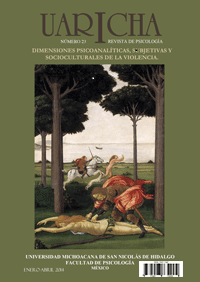Ethical issues of violence
Main Article Content
Abstract
Violence can burst in several scenarios of social and subjective order. From the point of view of psychoanalysis, violence is envisaged as a constitutive form of the conflictive nature of human beings, and as a virulent expression of death drive. Death drive can be poured outwards but it can also turn
against oneself. Within these symptoms, a violent impasse is found, which corners the subject but at the same time destroys confidence in oneself and others, of which can be a form of avoiding an atrocious subjugation. It can then be argued about an ethic of symptoms, located in the position of good which Freud referred to as primary and secondary gain of neurotic discomfort. When it comes to violence directed towards others and oneself, it can be seen that several discourses emerge and are wielded to sustain or attempt to sustain the mental capacity and reasoning for its doing. In this sense, there is a change from an ethics of symptoms to an ethics of violence, according to its tense and tangled discourse. Profit and benefits could be identified that tie evil with good through an exercise of violence. The three figures of subjects of violence that are suggested by Michel Wieviorka can be situated to clear up through these ethic knots which can subscribe the “advantageous” presence of enjoyment.
Article Details
Section

This work is licensed under a Creative Commons Attribution-NonCommercial-NoDerivatives 4.0 International License.
The authors have the right to ownership or copyright and they give to "Uaricha Psychology Magazine" the right to publish for the first time the article, as well as disclose and distribute it on the technological available media and through repositories.
Uaricha Psychology Magazine, is a quarterly publication, published by the Psychology College of the "Universidad Michoacana de San Nicolás de Hidalgo", Street Francisco Villa No. 450, Col. Dr. Miguel Silva, Morelia, Michoacán, P. C. 58110. Phone (+52) 443 312 9909, ext. 149, www.revistauaricha.umich.mx, uaricha.publicaciones@umich.mx. Responsible publisher: Roberto Oropeza Tena. Reserve of exclusive use rights No. 04-2013-070413365500-203, e-ISSN: 2007-7343, Granted by the National Institute Copyright. Responsible of the last update of this number, Computer center of the Psychology College, Ing. Erick Vidar Alva Rangel.
How to Cite
References
Alnaes, K; (2004). La verdadera historia de Sabina Spielrein. Madrid: Ed. Siruela
Arendt, H. (2003). Eichmann en Jerusalém. Un estudio sobre la banalidad del mal. Barcelona: Lumen
Assoun, P.-L. (1997). Psicoanálisis, Derecho y Criminología. En P.-L. Assoun, Psychanalyse [Psicoanálisis] (M. Orozco, Trans., pp. 589-611). Paris: Presses universitaires.
Camacho, F. (5 de noviembre de 2012,). Cuatro de cada 10 mujeres han sido agredidas por su pareja en México. La jornada, p. 425. Coetzee, J.M. (2006). El maestro de Petersburgo. México: DeBolsillo
Fanon, F. (2011). Los condenados de la tierra. México: FCE
Freud (1916/1999) Einie Charaktertypen aus der psychoanalytischen Arbeit. En S. Freud, Sigmund Freud. Gesammelte Werke. (Vol. X, pp.364-389). Frankfurt am Main: Fischer
Freud, S. (1916/2003). Algunos tipos de carácter dilucidados por el trabajo psicoanalítico. En J. Strachey (Ed.), Sigmund Freud obras completas (J. L. Etcheverry, trad.),(Vol.XIV, pp. 314-339). Buenos Aires: Amorortu
Freud (1917/1999) Die GemeineNerviosität. En S. Freud, Sigmund Freud. Gesammelte Werke. (Vol. XI, pp. 392-406) Frankfurt am Main: Fischer.
Freud, S. (1917/2003). El estado neurótico común. En J. Strachey (Ed.), Sigmund Freud obras completas (J. L. Etcheverry, trad.), (Vol. XIV, pp. 159-162). Buenos Aires: Amorortu.
Freud, S. (1919/2003). Lo ominoso. En J, Strachey (Ed.), Sigmund Freud obras completas (J.L. Etcheverry, Trad., Vol. 17, pp. 215-251). Buenos Aires: Amorrortu
Freud, S. (1920/2004). Más allá del principio de placer. En S. Freud y J. Strachey (Ed.), Sigmund Freud obras completas (J. L. Etcheverry, trad.), (Vol. XVIII, pp. 1-62.). Buenos, Aires: Amorrortu.
Freud, S. (1921/2004). Psicología de las masas y analisis del yo. En S. Freud y J. Strachey (Ed.), Sigmund Freud obras completas (J. L. Etcheverry, trad.,) (Vol. XVIII, pp. 63-136) Buenos, Aires: Amorrortu.
Galimberti, U. (2011). Qu’est-cequel’amour. Paris: Payot
Gerber, D. (2005). El estúpido encanto de la violencia. En. M. L. Sierra & M. Martinelli (Eds.), El psicoanálisis ante la violencia (pp. 11-33). México: Ediciones de la Noche.
Hobbes, T. (1989). Del ciudadano y Leviatán. Madrid: Tecnos
Kant, E. (1996). La paz perpetua. México: Porrúa
Lacan, J. (1953-54/1991). Seminario 1, Los escritos técnicos de Freud. Buenos Aires: Paidós
Lacan, J. (1954-55/2001). Seminario 2, El yo en la teoría de Freud y en la técnica Psicoanalítica. Buenos Aires: Paidós
Lacan (1969-70/1998). El reverso del psicoanálisis. Buenos Aires: Paidós
Levi, P. (2012). Trilogía de Auschwitz Los hundidos y los salvados. Madrid: Ed. Océano.
Loza, E. y Padgett, H. (2012) Los muchachos perdidos. Retratos e historias de una generación entregada al crimen. México: Debate.
Major, R. (2000). Al comienzo. La vida, la muerte. Buenos Aires: Nueva Visión
Muchembled, R. (2010) Una historia de la violencia. Del final de la Edad Media a la actualidad. Madrid: Paidós.
Pelt, J., Mazoyer, M., Monod, T. y Girardon, J. (2001). La historia más bella de las plantas. Las raíces de nuestra vida. Barcelona: Ed. Anagrama
Pereña, F. (2004). De la violencia a la crueldad. Madrid: Síntesis
Rajchman, J. (2001). Foucault y la cuestión de la ética. México: Editorial Psicoanalitica de la letra.
Reyna, J.C. (2011). Confesión de un sicario. México: Grijalbo.
Tolstoi, L. (2008). Guerra y paz. México: Grupo Editorial Tomo.
Sibony, D. (1998). Violence. Paris: Seuil.
Wieviorka, M. (2005). La Violence. Paris: Hachette.
Zizek, S. (2004). Mirando el sesgo. Buenos Aires: Paidós

